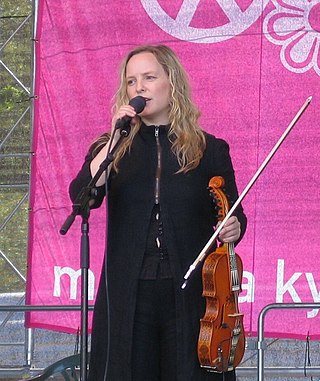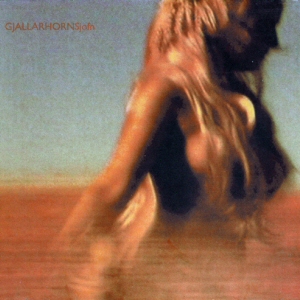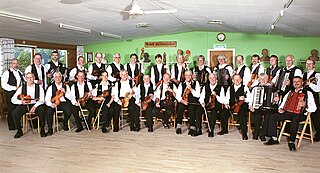Related Research Articles

The Donegal fiddle tradition is one of the distinct fiddle traditions within Irish traditional music. The distinctness of the Donegal tradition developed due to the close relations between County Donegal and Scotland, and the Donegal repertoire and style has influences from Scottish fiddle music. For example, in addition to the ”universally known” standard Irish dance tunes, there is an added volume of Scottish and Nova Scotia tunes played, with even some tunes from Shetland and Orkney. This includes standard tune types such as double jigs, slip jigs, reels, and hornpipes. It has been claimed that Donegal musicians play more slip jigs than any other region of Ireland. This is potentially due to the geographical borders/mountains keeping Donegal's repertoire more locally-known for decades. There is also a prevalence of mazurka playing. Mazurkas are historically mainland-European tunes very similar to a waltz, in its 3
4 meter, though generally livelier and with more emphasis being placed on the second beat of each measure. Another uniquely Donegal tune is called the barndance, stemming from the Germanic schottische, also similar to the Norwegian reinlander. The barndance is very similar to a hornpipe, but slower than a reel; typically they are played with less of a hornpipe's “swing” and more of the “drive” of a reel.

A fiddle is a bowed string musical instrument, most often a violin. It is a colloquial term for the violin, used by players in all genres, including classical music. Although in many cases violins and fiddles are essentially synonymous, the style of the music played may determine specific construction differences between fiddles and classical violins. For example, fiddles may optionally be set up with a bridge with a flatter arch to reduce the range of bow-arm motion needed for techniques such as the double shuffle, a form of bariolage involving rapid alternation between pairs of adjacent strings. To produce a "brighter" tone than the deep tones of gut or synthetic core strings, fiddlers often use steel strings. The fiddle is part of many traditional (folk) styles, which are typically aural traditions—taught "by ear" rather than via written music.
The polka-mazurka is a dance, musically similar to the mazurka, but danced much like the polka. Many polka-mazurkas were composed by Johann Strauss II and his family. Johann Strauss I did not compose any of this type of music; the first polka-mazurka example written by the Strauss family was in the year 1854 by Johann Strauss II, entitled La Viennoise op. 144.The polka-mazurka was not credited to the Strauss family alone, as many Viennese composers in the 1850s era also wrote many examples. This variant of the polka was seen as cross-cultural, as many of its influences can be seen in the French-polka with its feminine and deliberate steps as well as the exciting schnell-polka, where Eduard Strauss composed many famous pieces of this type.
The Mazurka is a Polish musical form based on stylised folk dances in triple meter, usually at a lively tempo, with character defined mostly by the prominent mazur's "strong accents unsystematically placed on the second or third beat". The Mazurka, alongside the polka dance, became popular at the ballrooms and salons of Europe in the 19th century, particularly through the notable works by Frédéric Chopin. The mazurka and mazurek are often confused in Western literature as the same musical form.
Nordic folk music includes a number of traditions of Nordic countries, especially Scandinavian. The Nordic countries are Iceland, Norway, Sweden, Denmark and Finland.

The langeleik, also called langleik, is a Norwegian stringed folklore musical instrument, a droned zither.

Jenny Wilhelms is a Finnish musician. She studied classical and folk music in many Nordic countries. She has been the lead singer of the innovative folk band Gjallarhorn from 1994. Later, according to her bio for her appearance at the 2011 Tampere vocal music festival, she "specialises in vocal physiology for non-classical singers and teaches privately, gives masterclasses and works with choirs and ensembles".

J.P.P. is a group of Finnish folk musicians from Kaustinen. The group still uses the Kaustinen traditional settings with fiddles, harmonium and double bass, although their arrangements are more advanced than those of earlier generations of traditional musicians in the area. The group's repertoire consists of traditional tunes, as well as newly-composed music in old-style dance rhythms -- polskas, waltzes, schottisches, etc. -- as well as some Finnish-style tangos, and some jazz and bluegrass influences too.
The pols and springar are Norwegian folk dances in 3/4. They are essentially fast versions of the Nordic polska. The dance is considered to have come to Norway with labor immigration to the Norwegian mining industry in the 16th and 18th centuries. The dance is particularly widespread in Røros and the surrounding area – then often called rørospols.
The Slängpolska is a Swedish folk dance and sometimes also the description of certain folk music tunes. The dances bearing the name slängpolska can be divided into two major types.

Traditional Nordic dance music is a type of traditional music or folk music that once was common in the mainland part of the Nordic countries — Scandinavia plus Finland. The person who plays this kind of music might be called speleman (Swedish/Norwegian), spelman (Swedish), spel(l)emann (Norwegian), pelimanni (Finnish) or spillemand (Danish). Finnish traditional dance music is often called pelimanni music in English, while there does not seem to exist a similar, widespread term for the corresponding music from the other countries. It is often more meaningful to distinguish between the traditional dance music from different regions than between music from the countries as such. Some concepts in the field can be defined as Norwegian or Finnish, but most are either common to all four countries or local. Besides the dance music tradition, all countries also have other traditions of folk music that are not shared to a similar extent.
The hambo is a traditional dance that originated in Sweden in the late 19th and early 20th centuries. It is a couple dance in 3
4 time, danced to music played with a strong accent on the first beat and a tempo that varies from moderate to fast. The hambo is a dance with a fixed pattern and tunes almost always have a corresponding eight measure structure.
Dalecarlian is a group of North Germanic languages and dialects spoken in Dalarna County, Sweden. Some Dalecarlian varieties can be regarded as part of the Swedish dialect group in Gästrikland, Uppland, and northern and eastern Västmanland. Others represent a variety characteristic of a midpoint between West and East Scandinavian languages, significantly divergent from Standard Swedish. In the northernmost part of the county, a characteristic dialect reminiscent of eastern Norwegian is spoken. One usually distinguishes between the Dalecarlian Bergslagen dialects, which are spoken in south-eastern Dalarna, and Dalecarlian proper. The dialects are traditionally regarded as part of the Svealand dialect group.
Gammaldans or Gammeldans is a small set of Nordic dances that became broadly popular in the late 19th century. These were also the dances of the Nordic immigrant communities in the United States.
Swedish folk music is a genre of music based largely on folkloric collection work that began in the early 19th century in Sweden. The primary instrument of Swedish folk music is the fiddle. Another common instrument, unique to Swedish traditions, is the nyckelharpa. Most Swedish instrumental folk music is dance music; the signature music and dance form within Swedish folk music is the polska. Vocal and instrumental traditions in Sweden have tended to share tunes historically, though they have been performed separately. Beginning with the folk music revival of the 1970s, vocalists and instrumentalists have also begun to perform together in folk music ensembles.

The spelmanslag is an amateur organization of Swedish folk musicians, usually dominated by fiddles, who play tunes together. Often these groups play tunes from the specific area of Sweden with which they are affiliated. The term has also the same meaning for Norwegian folk music. Spelmanslag meetings tend to serve social function as much as they do musical ones; and money from paid performances generally goes to the group, rather than its constituent individuals.

Sjofn is an album by Gjallarhorn, a band from Finland. It was the band's second studio album, and was released in 2000. It combines striking singing by vocalist Jenny Wilhelms with vigorous Swedish folk-style accompaniment, but with a didgeridoo as an updated drone, an unusual combination admired by critics.

Pehr Hörberg was a Swedish artist, painter and musician. In 1769 he married the maid Maria Eriksdotter and they had three sons.

Danish traditional music is the music genre that has its roots in pre-modern Denmark. In this period it was common for towns to have one or more town musicians who played at dances, processions and certain rituals. In the 17th and 18th centuries, professional music performances were monopolized by town musicians, who also traveled into the neighboring rural areas to perform. Urban music and dance styles, often from other parts of Europe, penetrated the countryside and almost eradicated earlier styles. This period also saw the introduction of the fiddle as the most important instrument and the abandonment of earlier chain dances in favor of pair dances. Until around 1900, traditional music was the common musical culture of Denmark, but with increasing urbanization and the spread of classical music it became marginalized to rural areas.
References
- ↑ Eva Hof: Om notsamlingen efter Anders Törne, Stora Tuna, från 1690-talet. University of Trondheim, spring 1994, Only in Swedish.
- ↑ Riksspelman, Bengt Ohlson, former pupil to Ingvar Norman in the 1970s, one of those who documented most variants of polska
- ↑ Rättviks folkdanslag, Polska from Bingsjö Archived 2007-02-19 at the Wayback Machine
- ↑ Jeanette Eriksson Archived 2007-09-29 at the Wayback Machine
- ↑ Tore Härdelin Polska in A minor after Hultkläppen
- ↑ Polska från Rättvik Archived 2011-07-08 at the Wayback Machine
- ↑ Polska from Southern Dalarna Archived 2005-11-04 at the Wayback Machine
- Authors (see below). (1989). Polska i Norden. Svea fonogram: Stockholm.
A 56-page booklet and accompanying audio tape with 40 tunes. Cooperative venture of four Nordic institutes. Provides separate descriptions of music and dance traditions in the four Nordic countries in the local language, followed by complete translation in English. Nyberg, B. (Swedish contributor); Aksdal, B. (Norwegian contributor); Koiranen, A. (Finnish contributor); Koudal, H.K. & Nielsen, S. (Danish contributors); Nyhus, S., Ramsten, M., & Häggman, A. (contributors, origin not specified).
- Swedish dance videos, including but not limited to polska.
- Three Fiddlers
- Videos of traditional folk music by fiddlers and folk musicians of the Nordic countries. Examples of the styles mentioned in this article and more. tvfolk.net
- Svenskt visarkiv, the original documents from old collections
- Folkwiki, online sheet music collection